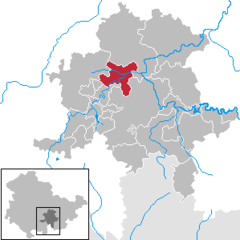Town in Thuringia, Germany
| Bad Blankenburg | |
|---|---|
| Town | |
 | |
 Coat of arms Coat of arms | |
Location of Bad Blankenburg within Saalfeld-Rudolstadt district
 | |
  | |
| Coordinates: 50°41′N 11°16′E / 50.683°N 11.267°E / 50.683; 11.267 | |
| Country | Germany |
| State | Thuringia |
| District | Saalfeld-Rudolstadt |
| Subdivisions | 8 |
| Government | |
| • Mayor (2024–30) | Thomas Schubert (CDU) |
| Area | |
| • Total | 35.56 km (13.73 sq mi) |
| Elevation | 220 m (720 ft) |
| Population | |
| • Total | 6,029 |
| • Density | 170/km (440/sq mi) |
| Time zone | UTC+01:00 (CET) |
| • Summer (DST) | UTC+02:00 (CEST) |
| Postal codes | 07422 |
| Dialling codes | 036741 |
| Vehicle registration | SLF |
| Website | www.bad-blankenburg.de |
Bad Blankenburg (German pronunciation: [bat ˈblaŋkənbʊʁk] ) is a spa town in the district of Saalfeld-Rudolstadt, in Thuringia, Germany. It is situated 6 km southwest of Rudolstadt, and 37 km southeast of Erfurt. It is most famous for being the location of the first kindergarten of Friedrich Wilhelm August Fröbel, in 1837.
To the north of it, on an eminence, rise the fine ruins of the castle of Greifenstein, built by the German king Henry I, and from 1275 to 1583 the seat of a cadet branch of the counts of Schwarzburg.
In the nineteenth century, Bad Blankenburg was part of the small principality of Schwarzburg-Rudolstadt.
Bad Blankenburg is the headquarters of Deutsche Evangelische Allianz, a cooperative network of most Protestant churches in Germany.
Historical Population
Historical Population (from 1960 as of 31 December):
|
|
|
|
|
- Data source from 1994: Thuringian Office for Statistics
Twin towns – sister cities
References
- Gewählte Bürgermeister - aktuelle Landesübersicht, Freistaat Thüringen. Retrieved 25 June 2024.
- "Bevölkerung der Gemeinden, erfüllenden Gemeinden und Verwaltungsgemeinschaften in Thüringen Gebietsstand: 31.12.2022" (in German). Thüringer Landesamt für Statistik. June 2023.
-
 One or more of the preceding sentences incorporates text from a publication now in the public domain: Chisholm, Hugh, ed. (1911). "Blankenburg". Encyclopædia Britannica. Vol. 4 (11th ed.). Cambridge University Press. p. 41.
One or more of the preceding sentences incorporates text from a publication now in the public domain: Chisholm, Hugh, ed. (1911). "Blankenburg". Encyclopædia Britannica. Vol. 4 (11th ed.). Cambridge University Press. p. 41.
External links
| Towns and municipalities in Saalfeld-Rudolstadt | ||
|---|---|---|
This Saalfeld-Rudolstadt location article is a stub. You can help Misplaced Pages by expanding it. |
